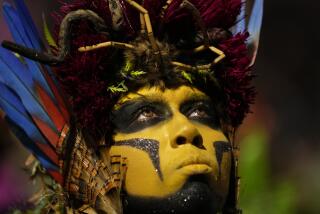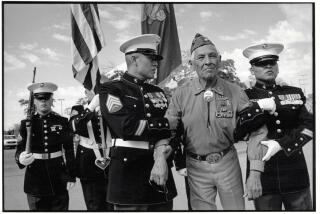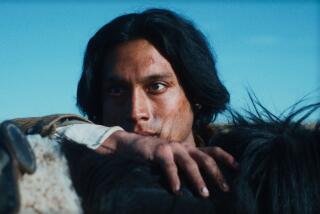Scientist a Fierce Advocate for a ‘Fierce People’
- Share via
Napoleon A. Chagnon isn’t your usual best-selling scientific author, and not just because of his imperial first name (“A parental bow to my French Canadian grandfather,” he explained).
He is chronicler of the largest remaining unassimilated aboriginal tribe, the Amazon basin’s 24,000 Yanomamo Indians, who live in isolated rain forest villages along the Venezuela-Brazil border.
His 1968 pioneering study, “Yanomamo: The Fierce People,” has been required reading for generations of anthropology students and helped make the Yanomamo what Harvard sociobiologist Edward O. Wilson calls the world’s “most famous preliterate” people.
Now the controversial UC Santa Barbara scientist is marking a milestone. His classic text is out in a fifth edition.
Published by Harcourt Brace simply as “Yanomamo”--in a reluctant bow, he says, to colleagues who “like to make themselves look morally pure by saying Chagnon denigrates the Yanomamo by calling them fierce”--the new edition should push total sales for the book to a record 1 million copies.
“This is probably the all-time best-selling textbook in the entire history of cultural anthropology,” Chagnon said.
Like its 59-year-old author, “Yanomamo” is blunt and hard-hitting, unsparing of “do-gooder” critics, coolly objective about its subjects and filled with almost as many nail-biting episodes as an Indiana Jones flick.
The no-punches-pulled tone, Chagnon said, is a reaction to what he calls anthropological “garbage” he learned in graduate school perpetuating the myth of primitive people as “noble savages.”
“So I decided to tell students what it was really like to do field research in a tribal society where they didn’t give a damn whether you lived or died,” he said in a recent interview, “to include all the cheating, lying, deceit, wife-beating, chicanery.”
And that, he added without a trace of modesty, “turned out to be a revolution in writing anthropology.”
Chagnon’s “revolution” began in 1964, when as a doctoral student at the University of Michigan looking for a thesis topic, he selected the Yanomamo. “I wanted the most isolated, unknown tribe I could find,” he said, “and this one tribe in Venezuela and Brazil fit the bill.”
The Yanomamo--a name that means “the people” in their tribal language--were barely known to the scientific world, although vague reports of “savages” living along the Orinoco River’s headwaters dated back to the early 19th century.
Chagnon set up camp in Bisaasi-teri, a typical Yanomamo village of open-faced thatched huts on Venezuela’s side of the unmarked border.
Probably one of the first white men many of the villagers had seen, he vividly described the first encounter: “I looked up and gasped to see a dozen burly, naked, sweaty, hideous men staring at us down the shafts of their drawn arrows. Immense wads of green tobacco were stuck between their lower teeth and lips, making them look even more hideous, and strands of dark-green slime dripped from their nostrils. . . . We had arrived as the men were blowing ebene, a hallucinogenic drug, up each other’s noses.”
The Yanomamo warriors did not attack, but things didn’t get much better for the young scholar, then 26. As he settled into his hut, he found the Yanomamo watching everything he did. At meals, they begged for food. If he tried to become friends, they’d demand some of his precious supplies.
“The hardest thing I had to learn to live with,” he said, “was the incessant, impassioned and often aggressive demands”--for knives, rides in his canoe, use of his shotgun, doses of medicine. “I was bombarded by such demands day after day, month after month, until at times I could not bear to look at a Yanomamo.”
There were other trials as well--roaches as big as small birds, voracious biting gnats, the ordeal of preparing something as simple as a bowl of oatmeal.
But Chagnon was too stubborn to give up. To get along with the Yanomamo, he realized, he had to become like them--”somewhat sly, aggressive, intimidating and pushy.” He went so far as to dress like a Yanomamo male, wrapping a string around his waist and tying it to his penis.
Gradually, the Yanomamo became fond of their strange, redheaded visitor (as he did of them). Calling him shaki, a pesky bee, they let him take part in their orgiastic, vomiting feasts of banana soup and peach palm gruel during which, he writes, “one must be careful not to walk in front of a celebrant about to regurgitate.” They offered him their drugs and let him tag along with hunting and war parties.
Visiting a neighboring village, he encountered an angry headman who threatened to club him to death because Chagnon had given machetes to the chief’s enemies. One night a jaguar started sniffing at him--and retreated only after an alert Yanomamo guide shone a light in the beast’s eyes.
Chagnon soon realized that the Yanomamo had a single, all-consuming preoccupation with warfare. “It affected almost everything they did,” he says, shaping their mythology, rituals, settlement patterns, political behavior and marriage practices.
The fighting was mostly over women. Typically, it was set off by the seizure of a married woman by another man within the village or abductions of women by raiders from other villages.
In his first 15 months of fieldwork, one of his study villages was raided no fewer than 25 times--six times by the very group with which he was living. He reckoned that about 40% of all Yanomamo men had been involved in killings--and, moreover, were proud of it.
When Chagnon published these astonishing findings, he set off an academic firestorm. Colleagues accused him of exaggerating Yanomamo killing--and especially took issue with his claim that the bloodiest warriors had the greatest “reproductive success.”
“He has taken a small part of a society and built an identity card for [an entire] people,” chided anthropologist Bruce Albert of the Research Institute for Cooperation and Development in Paris.
But Chagnon, who said the Yanomamo themselves boast of their fierceness, stands by his work. He said his detractors resent him “because my years of fieldwork make their casual visits to the Yanomamo villages look pretty skimpy as serious anthropological research.”
Lately, Chagnon has also been quarreling with the Salesians, Roman Catholic missionaries in Yanomamo territory. Although he acknowledges their good works, he said they are destroying Yanomamo society, even if unintentionally. They do this, he said, by luring whole villages to their missions with promises of desired goods, including shotguns, but failing to provide adequate medical care when they contract unfamiliar diseases such as measles.
For a while the quarrel got so bad that the Venezuelan government kept Chagnon from visiting the Yanomamo--apparently, he said, because of pressure from his enemies.
He has been allowed to resume his annual field trips and recently even got access to Yanomamo villages in Brazil, which have long been wary of foreign researchers. But, as Chagnon’s new edition emphasizes, the news from Yanomamo country isn’t good.
Increased contacts with the outside world, he said, are tearing up Yanomamo culture. Especially devastating has been the invasion of illegal gold miners--garimpeiros--from Brazil who, he said, have appropriated ore-rich Yanomamo land, polluted rivers with their mining operations, spread disease and killed and raped hundreds of Yanomamo.
Chagnon, who has become a fierce advocate of his “fierce people,” is deeply concerned about their future. At the very least, he hopes the latest edition of his milestone book will help keep the public spotlight on them.
More to Read
Sign up for our Book Club newsletter
Get the latest news, events and more from the Los Angeles Times Book Club, and help us get L.A. reading and talking.
You may occasionally receive promotional content from the Los Angeles Times.










